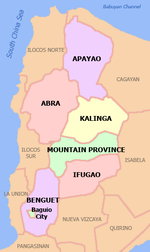Tabuk, Kalinga
Tabuk | |
|---|---|
| City of Tabuk | |
 Cathedral of the Episcopal Church in the Philippines, Tabuk City | |
 Map of Kalinga with Tabuk highlighted | |
Location within the Philippines | |
| Coordinates: 17°24′25″N 121°26′33″E / 17.4069°N 121.4425°E | |
| Country | |
| Region | Cordillera Administrative Region |
| Province | Kalinga |
| District | Lone District |
| Founded | June 16, 1950 |
| Cityhood | June 23, 2007 (Lost cityhood in 2008 and 2010) |
| Affirmed Cityhood | February 15, 2011 |
| Barangays | 42 (see Barangays) |
| Government | |
| • Type | Sangguniang Panlungsod |
| • Mayor | Ferdinand B. Tubban |
| • Electorate | 70,281 voters (2022) |
| Area | |
| • Total | 700.25 km2 (270.37 sq mi) |
| Population (2020 census)[3] | |
| • Total | 121,033 |
| • Density | 170/km2 (450/sq mi) |
| Time zone | UTC+8 (PST) |
| ZIP code | 3800 |
| PSGC | |
| IDD : area code | +63 (0)74 |
| Income class | 5th city income class |
| Revenue (₱) | ₱ 1,186 million (2020) |
| Native languages | Kalinga Ga'dang Ilocano Tagalog |
| Website | www |
Tabuk, (Ilocano: Siudad ti Tabuk), officially the City of Tabuk, or simply referred to as Tabuk City, is a 5th class component city and capital of the province of Kalinga, Philippines. According to the 2020 census, it has a population of 121,033 people.[3]
Tabuk City is 461 kilometres (286 mi) from Manila via Cauayan/Roxas and 443 kilometres (275 mi) via San Mateo/Roxas.
History
The former municipal district of Tabuk was transformed into a regular municipality by Republic Act No. 533, approved June 16, 1950.[4]
Cityhood
Barangays
Tabuk is politically subdivided into 42 barangays. [2]
- Agbannawag
- Amlao
- Appas
- Bagumbayan
- Balawag
- Balong
- Bantay
- Bulanao
- Bulanao Norte
- Cabaritan
- Cabaruan
- Calaccad
- Calanan
- Dilag
- Dupag
- Gobgob
- Guilayon
- Ipil
- Lanna
- Laya East
- Laya West
- Lucog
- Magnao
- Magsaysay
- Malalao
- Masablang
- Nambaran
- Nambucayan
- Naneng
- Dagupan Centro (Poblacion)
- San Juan
- Suyang
- Tuga
- Bado Dangwa
- Bulo
- Casigayan
- Cudal
- Dagupan West
- Lacnog
- Malin-awa
- New Tanglag
- San Julian
Demographics
| Year | Pop. | ±% p.a. |
|---|---|---|
| 1918 | 4,079 | — |
| 1939 | 3,343 | −0.94% |
| 1948 | 7,376 | +9.19% |
| 1960 | 21,261 | +9.22% |
| 1970 | 28,016 | +2.79% |
| 1975 | 33,918 | +3.91% |
| 1980 | 42,768 | +4.74% |
| 1990 | 57,200 | +2.95% |
| 1995 | 63,507 | +1.98% |
| 2000 | 78,633 | +4.69% |
| 2007 | 87,912 | +1.55% |
| 2010 | 103,912 | +6.27% |
| 2015 | 110,642 | +1.20% |
| Source: Philippine Statistics Authority[5][6][7][8] | ||
In the 2020 census, the population of Tabuk was 121,033 people,[3] with a density of 170 inhabitants per square kilometre or 440 inhabitants per square mile.
Languages
Tabuk is home to two indigenous languages, the Kinalinga language which is used throughout the Kalinga province a town in Mountain Province, and the Malaweg language which is used in Tabuk and southwest Cagayan province. In the 1970s, Ilokano migrants came to the province and imported the Ilokano language during the martial law era.
References
- ^ City of Tabuk | (DILG)
- ^ a b "Province: Kalinga". PSGC Interactive. Quezon City, Philippines: Philippine Statistics Authority. Retrieved 12 November 2016.
- ^ a b c Census of Population (2020). "Cordillera Administrative Region (CAR)". Total Population by Province, City, Municipality and Barangay. Philippine Statistics Authority. Retrieved 8 July 2021.
- ^ "R.A. No. 533: An Act to Convert the Municipal District of Tabuk, Sub-province of Kalinga, Mountain Province, into a Regular Municipality to be Known as the Municipality of Tabuk". PhilippineLaw.info. Archived from the original on 4 January 2015. Retrieved 4 January 2015.
{{cite web}}: Unknown parameter|deadurl=ignored (|url-status=suggested) (help) - ^ Census of Population (2015). "Cordillera Administrative Region (CAR)". Total Population by Province, City, Municipality and Barangay. Philippine Statistics Authority. Retrieved 20 June 2016.
- ^ Census of Population and Housing (2010). "Cordillera Administrative Region (CAR)" (PDF). Total Population by Province, City, Municipality and Barangay. National Statistics Office. Retrieved 29 June 2016.
- ^ Censuses of Population (1903–2007). "Cordillera Administrative Region (CAR)". Table 1. Population Enumerated in Various Censuses by Province/Highly Urbanized City: 1903 to 2007. National Statistics Office.
{{cite encyclopedia}}: CS1 maint: numeric names: authors list (link) - ^ "Province of Kalinga". Municipality Population Data. Local Water Utilities Administration Research Division. Retrieved 17 December 2016.



